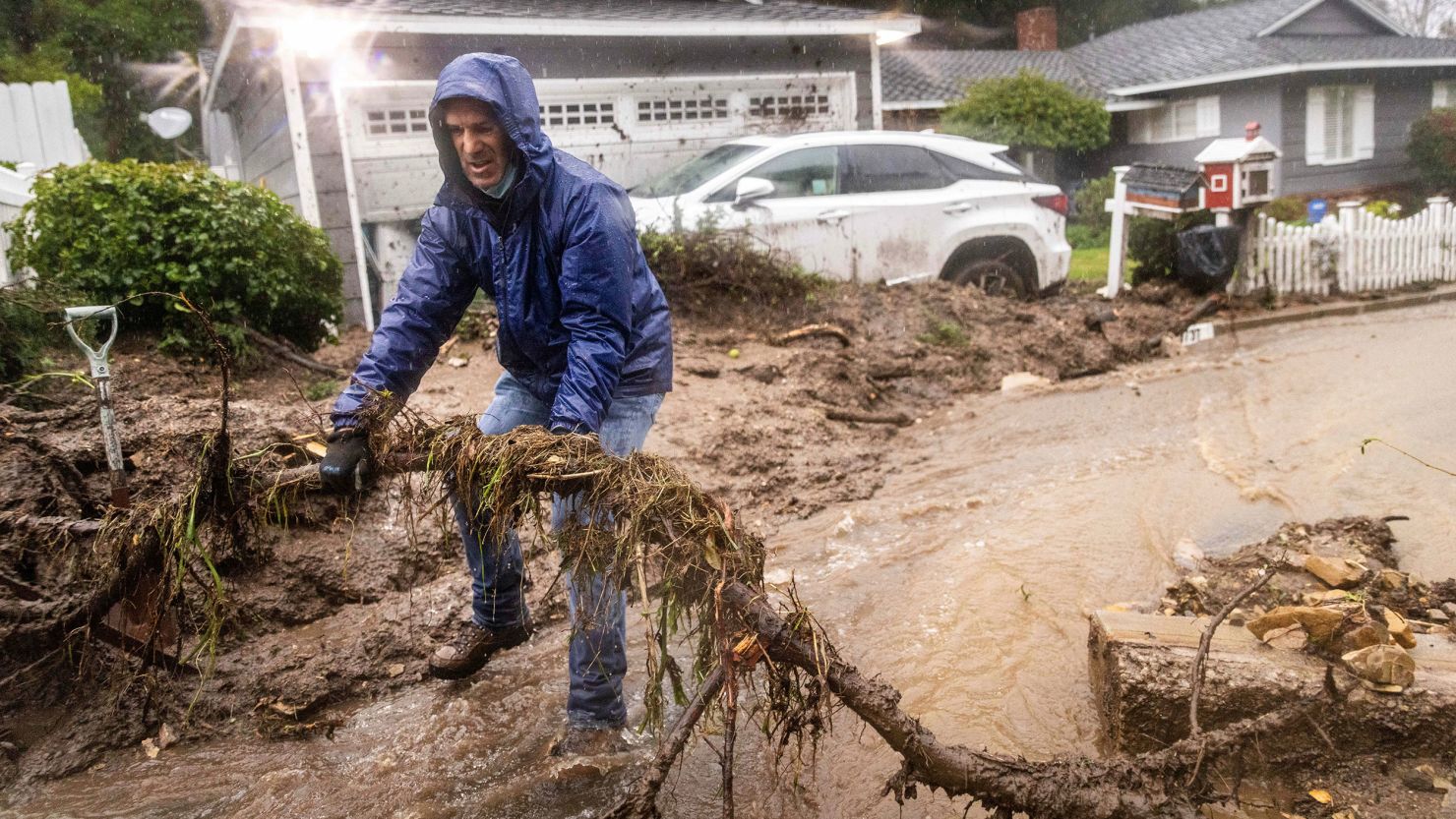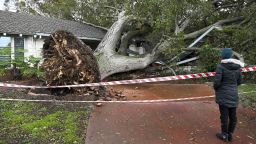Story highlights
A rare Level 4 of 4 risk of excessive rainfall is in effect for more than 16 million across Southern California
Submerged roadways and damaging debris flows were reported early Monday
The extended period of relentless downpours comes as much of the state is already saturated by recent record rainfall
An intense, long-lasting atmospheric river is moving across California — bringing widespread power outages, mudslides and life-threatening flooding as it dumps heavy rain and snow. Follow our live coverage here. This is what’s happening:
• Rare high flood risk persists: A firehose of rain has parked over Southern California, worsening flooding conditions Monday with rain set to linger into Tuesday. Some parts of Los Angeles County have already seen nearly a foot of rain and on-and-off showers are expected to persist Tuesday and expand south into San Diego.
• At least 2 fatalities reported: A man in Yuba City, about 40 miles north of Sacramento, was killed Sunday by a large redwood tree that fell as winds of nearly 50 mph hit the area. “Through the investigation, it appeared he was possibly using a ladder to try and clear the tree away from his residence when it fell on him,” the Yuba City Police Department said in a statement. Further south, a 45-year-old man was killed in Santa Cruz County after a tree fell into a Boulder Creek home Sunday, a Santa Cruz County Sheriff’s Office spokesperson said.
• More than 120 mudslides: In Los Angeles, more than 120 mudslides were reported and about 25 structures were damaged, Los Angeles Fire Chief Kristin Crowley said Monday. The weather service earlier warned of an “extremely dangerous situation” in the Hollywood Hills area – where homes have been evacuated – and around the Santa Monica Mountains. “Numerous damaging landslides, flooded roadways, submerged vehicles, and flooded creeks and streams are ongoing,” in an area that includes Malibu, Beverly Hills, Santa Monica, Brentwood and Burbank, the service said.
• A historic downpour in Los Angeles: The torrential downpour brought an astonishing 6.65 inches of rain since Sunday to downtown Los Angeles, marking the third-wettest two-day stretch the city has seen since January 26, 1956. February is typically the wettest month of the year in Los Angeles, with an average of 3.64 inches of rain in total downtown.
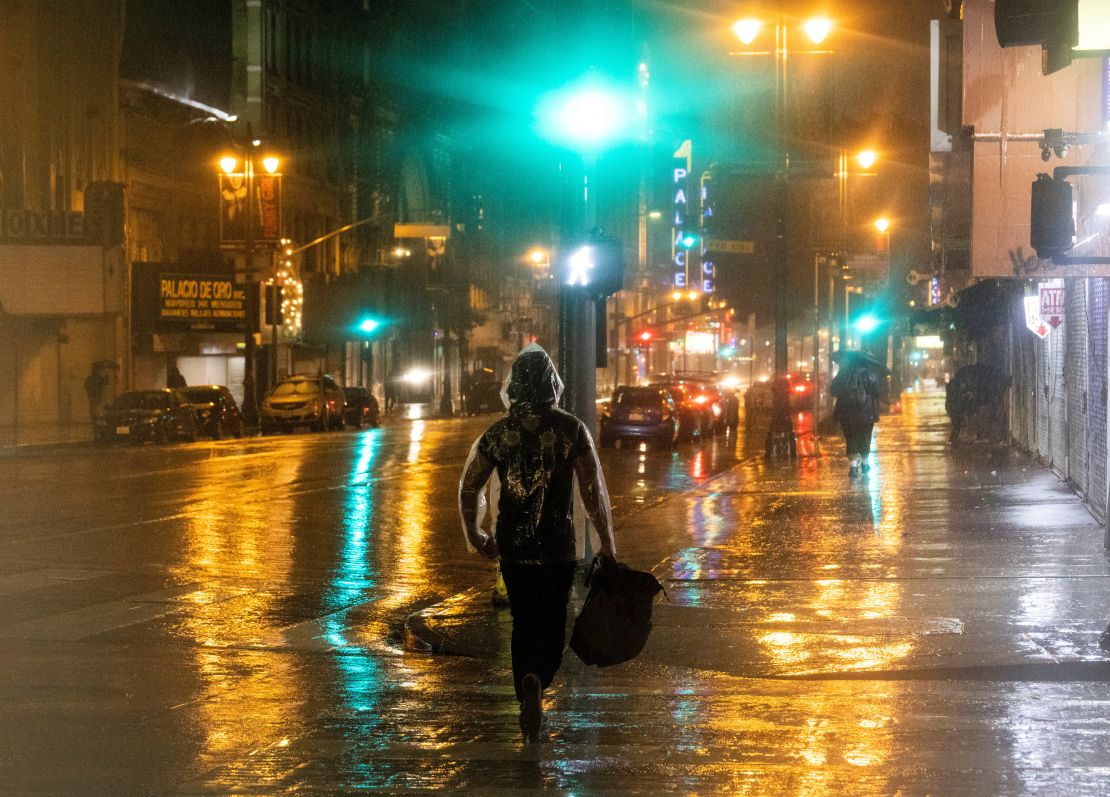
• Power outage numbers remain high: Strong winds and rain have knocked out power for nearly 300,000 customers in California, particularly along the coast, according to the tracking website PowerOutage.us. The majority of outages are across the northern half of the state where winds gusted as high as 100 mph over the past day.
• Major air travel headaches: Heavy rains and gusty winds have caused flight disruptions at several of California’s major airports. More than 1,000 flights in and out of Los Angeles International Airport have been delayed since Sunday, according to tracker FlightAware, and San Francisco International Airport has had more than 200 cancelations and over 800 delays in the same period. Airports in San Diego, Oakland and Sacramento have also seen disruptions.
• Rare rain risk: The Weather Prediction Center issued a rare high risk of excessive rainfall - or a Level 4 of 4 - for more than 16 million people across Southern California on Monday. This includes downtown Los Angeles, Anaheim and Long Beach. In Central and Southern California, widespread rainfall totals of 3 to 6 inches are expected – more than a month’s worth of rain for most areas in several days.
• Storm causes avalanche in Nevada: The same storm system helped cause an avalanche in the Lee Canyon and Mount Charleston areas, northwest of Las Vegas, according to the Las Vegas Metropolitan Police Department. Lee Canyon has received about a foot of snow in the last 24 hours. Several people were reported missing after the incident but have been found.
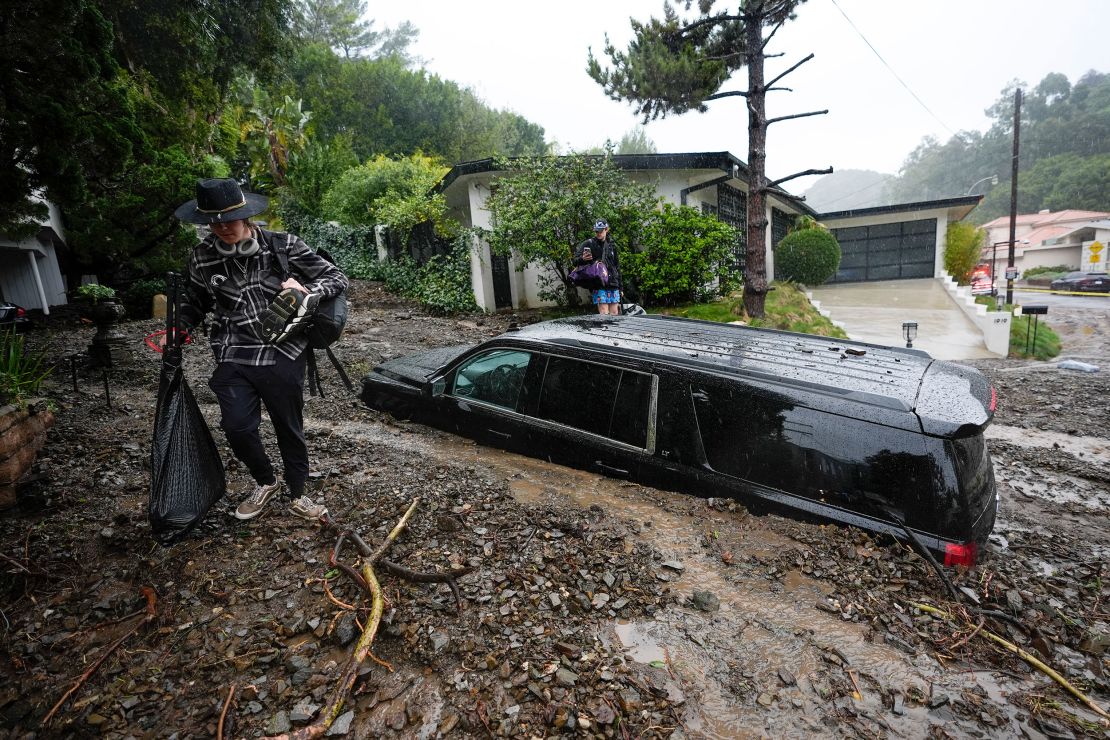
• Almost a foot of rain in Bel-Air: Heavy rain doused the ritzy Los Angeles community of Bel-Air with more than 11 inches of rain since Sunday afternoon, according to the weather service. “Due to the hilly nature of our canyons, there are multiple mudslides and landslides, and tons of debris in our roads. Many of the roads are closed,” Bel-Air Association spokesperson Hattie Rogovin told CNN.
• Storm hinders travel in the mountains: Significant snowfall is burying parts of the Sierra Nevada and Southern California’s mountain ranges, with heavy snow expected through Tuesday afternoon. Heavy, wet snow will reach pass level for some travelers and pose “very difficult-to-impossible” conditions, according to the National Weather Service. Parts of the Sierras have already recorded more than 2 feet of snow this week, with several more inches coming Tuesday.
• Some schools closed: All Malibu schools are closed Monday, the Santa Monica-Malibu Unified School District announced on X, citing road closures and the inability of some staff to get to schools. Several school districts in Santa Barbara County canceled classes due to the severe weather, and Pepperdine University in Malibu canceled in-person classes. Others schools, including California State University Fullerton, switched to remote learning.
• Two bigger factors are making this worse: Scientists say the broader climate crisis and El Niño are increasing the rainfall and destructive power of this storm. When El Niño has a strong presence in the Pacific Ocean, it can intensify atmospheric river events on the West Coast.
Atmospheric river still slamming California
This strong type of atmospheric river – a long, narrow moisture band that carries saturated air thousands of miles then discharges it like a fire hose – is called a Pineapple Express. It’s carrying moisture buildup from the Pacific Ocean near Hawaii and walloping the US and Canadian West coasts with heavy rain and snow, according to the National Oceanic and Atmospheric Administration.
The strongest winds associated with the system have subsided, but there are still gusts up to 50 mph across the higher elevations of Central and Southern California. Wind advisories are in place across Central California and in Orange and San Diego counties Monday morning.
The atmospheric river impacting California this week follows another recent storm that drenched most of the state, including Los Angeles, with record rainfall. As the state braced for flooded roadways and swollen rivers, Gov. Gavin Newsom on Sunday declared a state of emergency for Los Angeles, Orange, Riverside, San Bernardino, San Diego, San Luis Obispo, Santa Barbara and Ventura counties.
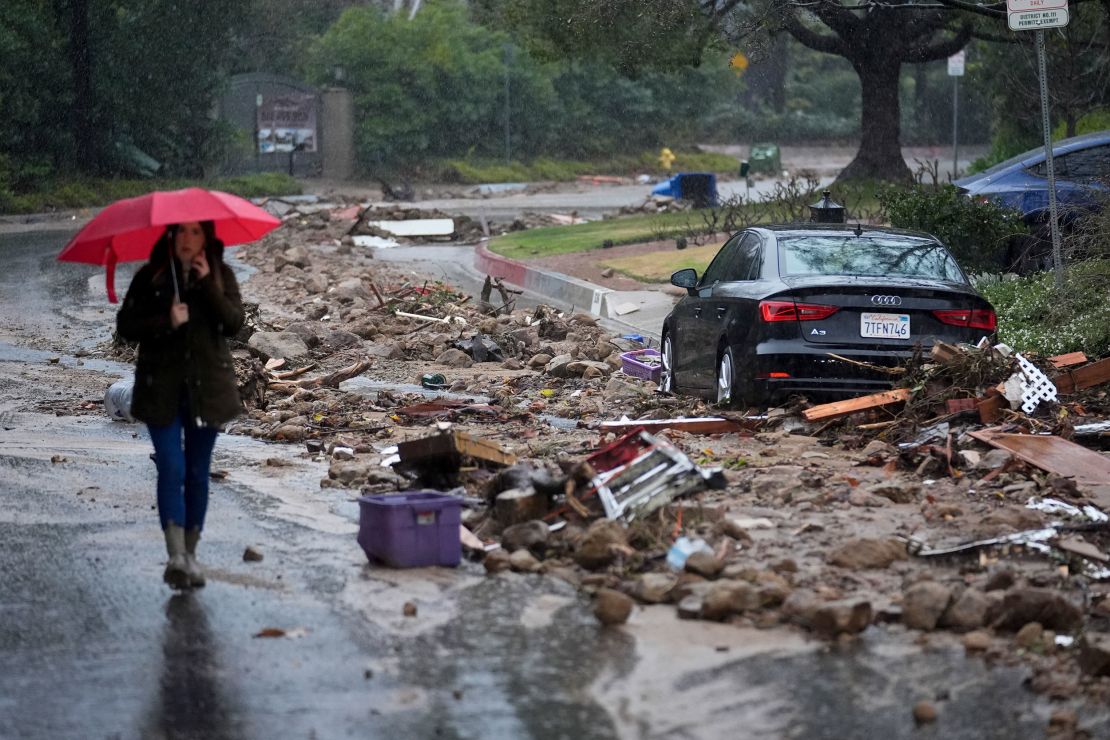
Southern California continued to prep for the prolonged impacts of the storm, which parked as it moved onshore, bringing a much longer duration of rain compared to the last storm. Californians can expect to see the worst of the storm’s impacts through Tuesday, according to the weather service.
In Los Angeles, officials urged residents to stay off the roads and stay home, if possible – even sending a flash flood emergency alert to phones Sunday evening telling people not to travel due to the “dangerous and life-threatening situation.” All lanes of Interstate 5 were flooded in San Fernando in Los Angeles County as of late Sunday evening. A flash flood warning in place for western and central Los Angeles County covers more than 2.5 million people.
Los Angeles Mayor Karen Bass signed a declaration of a local emergency Monday, saying it will help the city respond to the storm now and during the recovery.
President Joe Biden spoke by phone with Newsom and Bass Monday evening about the availability of federal support, if needed, the White House said. FEMA has already staged personnel and resources in the state to ensure support can be mobilized if requested, it added.
Bass asked residents to follow evacuation orders to help out first responders.
“We have had to rescue individuals in certain neighborhoods because they did not follow the evacuation orders,” Bass said at a news conference Monday. “We ask that when notified that you need to evacuate, please do that so you do not end up needing to be rescued.”
Officials rescued a man Monday who had jumped into the Los Angeles River to save his dog in the fast-moving water, the Los Angeles Fire Department said.
A helicopter crew lowered a rescuer into the rain-swollen river, who was able to grab the man and hoist him to safety, officials said. The dog managed to swim safely to the edge of the river and “escape the rapids,” the department said. The man was taken to a hospital and his dog was taken to a shelter for minor injuries and temporary care.
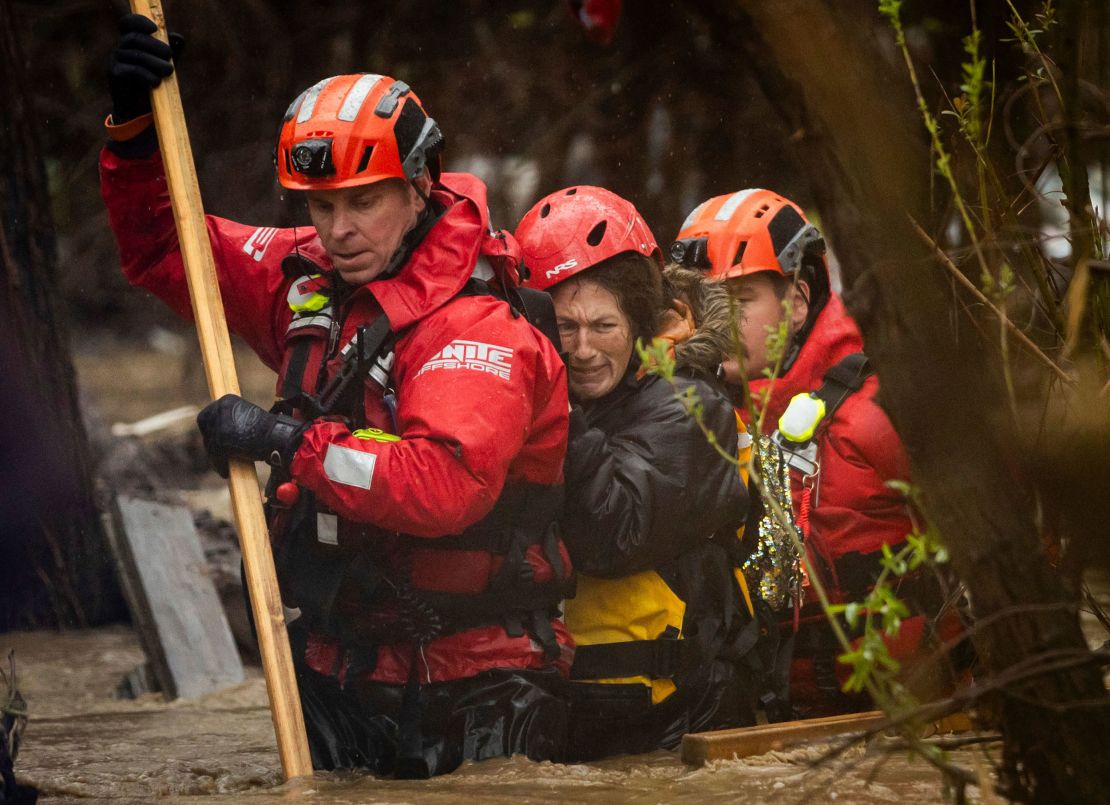
The worst of the storm’s rainfall is set to slowly expand south throughout Monday, with the threat moving to include more of the San Diego area by the evening.
San Diego Mayor Todd Gloria told CNN Monday the city was preparing but the downpour followed another recent storm that sent several feet of water rushing through some streets and prompted hundreds of rescues.
“We’ve seen areas that have not traditionally flooded flood because of the volume of rain in a very short amount of time,” he said. “These atmospheric rivers are something that probably many of us never even grew up with knowing about, but now they’re sort of ever-present in our lives.”
Low-lying and flood-prone areas of San Diego were issued an evacuation warning, according to Gloria. The city will likely see somewhere between 2 and 2.5 inches of rain through Tuesday, with some areas potentially getting half an inch of rain per hour, he said.
As the rain moved in over San Diego, salvage workers dressed in hazmat suits were traipsing in and out of Louis Edwards’ San Diego home Monday, cataloging his every possession after nearly everything he owns was destroyed by rain-induced floodwaters that besieged his neighborhood nearly two weeks ago.
He said he barely escaped the last storm, having to swim through his front door as water rushed into his home. He climbed onto the roof of his minivan, which he says was only about an inch above water. He doesn’t have much to lose this time.
“I just take one day at a time,” he told CNN. “That’s all, I can’t do no more otherwise than that.”
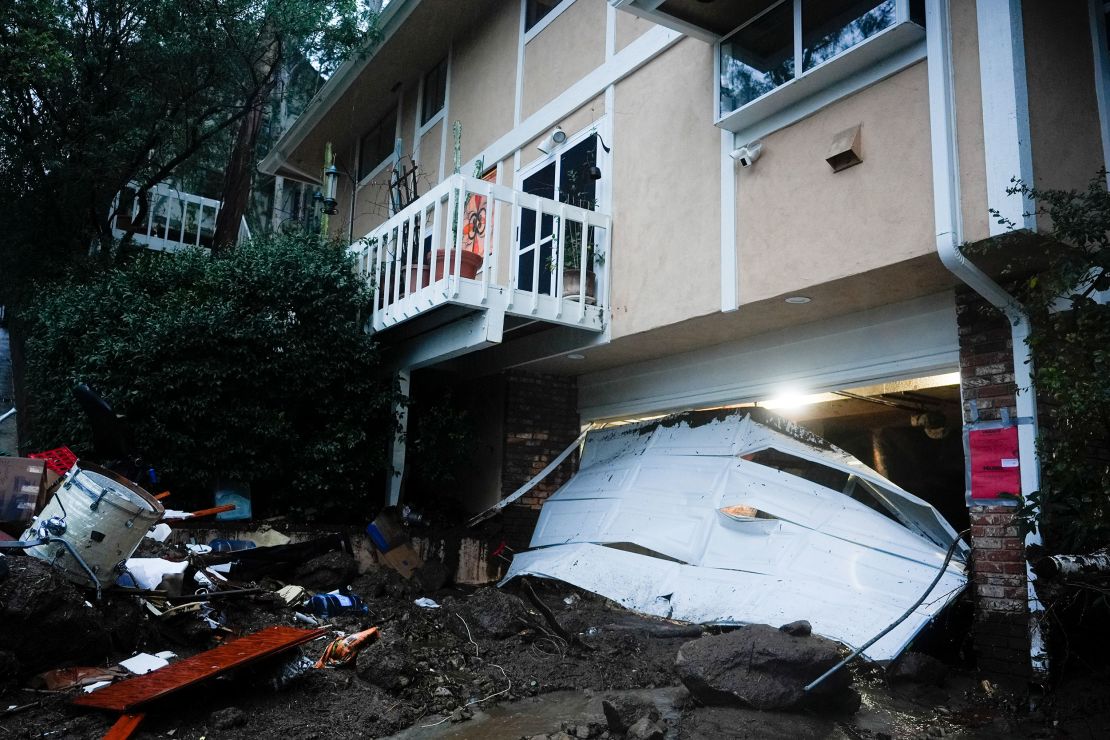
Across Los Angeles, damage and evacuations were reported. Two homes in the Studio City area were damaged and nine others were evacuated after debris flow in the area, according to the fire department. In the Encino area, three homes were impacted by debris flow and several people were evacuated, the department said.
Debris flows are “fast-moving landslides” that destroy objects, and can occur during periods of intense rainfall, according to the US Geological Survey.
North in Ventura County, the storm’s dangers began taking shape on Sunday after law enforcement reported several flooded roads, submerged vehicles, rock and mudslides and quickly rising river levels, according to the weather service.
In San Bernardino County, three people were rescued after becoming stranded in a tree while trying to cross a flooded road in their vehicle, the San Bernardino County Fire Department said on X Monday morning.
Two factors making this storm worse
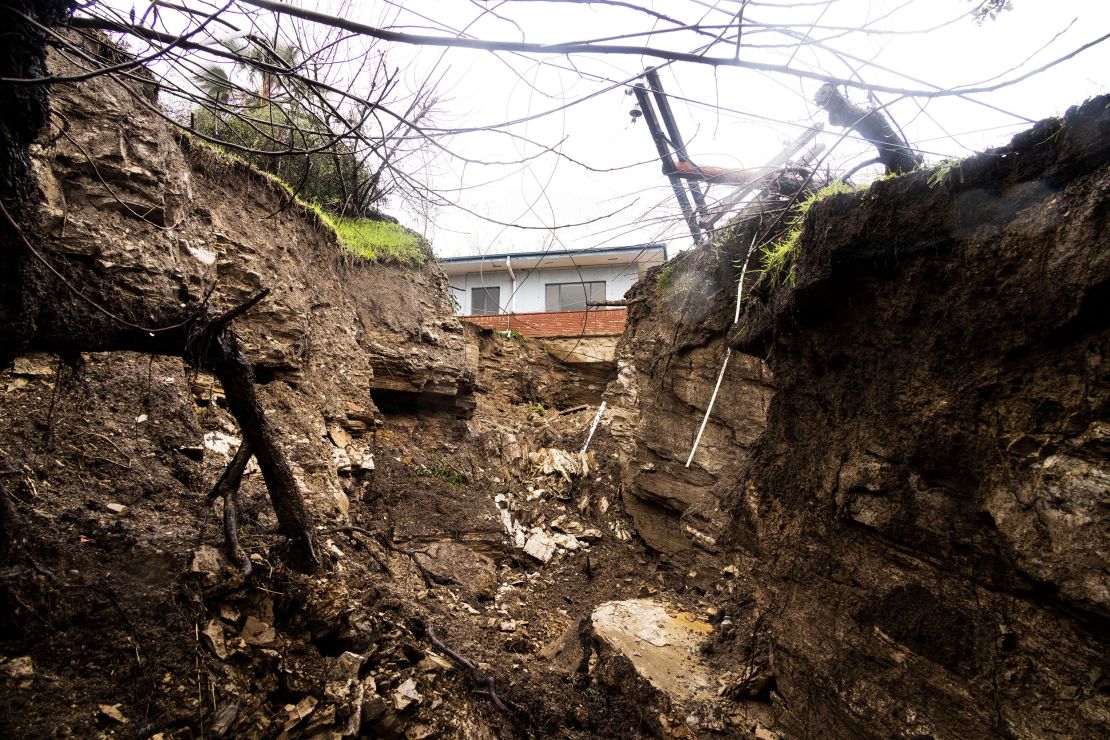
Scientists point to two factors that are increasing the rainfall and destructive power of this week’s storm: the broader climate crisis and El Niño.
On top of the global warming trend and ocean temperatures at record highs, a strong El Niño is present in the Pacific – a phenomenon that can enhance atmospheric river events on the West Coast.
California, which is recovering from a historic megadrought that triggered water restrictions, has seen a deluge of heavy rain and snowstorms since last winter.
These dramatic swings between the two extremes – extreme drought and high precipitation – also known as weather whiplash, is another phenomenon that scientists warn will happen more often on a warming planet in coming decades.
CNN’s Cindy Von Quednow, Amy Simonson, Christal Hayes, Joe Sutton, Jeffrey Kopp, Tina Burnside, Nouran Salahieh, Allison Chinchar, Caitlin Kaiser, Sara Tonks, Elisa Raffa, Nikki Carvajal and meteorologists Mary Gilbert and Brandon Miller contributed to this report.

